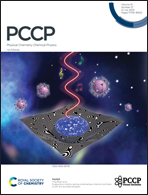Machine learning-aided band gap prediction of semiconductors with low concentration doping†
Abstract
The important physical quantities of materials, such as band gap, have been predicted efficiently with the help of machine learning (ML), in addition to the widely used experimental or computational methods. Under this scheme, by combining density functional theory (DFT) calculations and ML predictive models, the band gaps of doped semiconductors with normal doping concentrations are predicted successfully. Our present work provides a solution to the problem of how to obtain the band gaps of semiconductors doped with extremely low concentrations, which are important cases for some device designs. The structures were constructed by configuration screening with a symmetric criterion, and three-dimensional spatial structural variation was mapped to one-dimensional features, which are the key steps for the ML predictive model. The biggest error in the predicted band gaps of dilute nitride-doped GaAs by ML models is not more than 10%, compared with values obtained from DFT. Considering the limitation of material data, a few-shot learning method was further adopted to check the performance of the predictive models. The performance of the ML models was validated using data out of training and testing datasets. Our method will efficiently accelerate the prediction of physical properties of semiconductors with extremely low-concentration doping.



 Please wait while we load your content...
Please wait while we load your content...